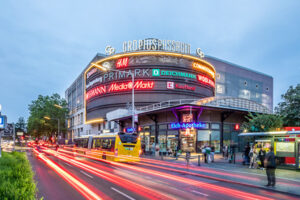By Katharina von Schacky
But if we are honest, we all know that digitalisation has only been a catalyst for a trend that was already present: a closer focus on the consumer and his needs, which led to a necessary review of how retailers distribute their products, as well as the speed at which they do it. This was stimulated by an overall change in consumer behaviour, where convenience and opinion play increasingly important roles in the decision to buy something (or not).
I am sure you would agree that Amazon was probably one of the biggest game changers. Many blame the company for “killing” a large number of retailers, eventually leading to a decline in brick and mortar sales. But is this true? I see various advantages Amazon had on its side: timing for one. Many retailers had simply not thought about improving their ways of distributing their products more quickly and conveniently to consumers. Although it was obvious that consumers wanted goods quickly and conveniently, most stores either did not want to see it, or were unable to deliver.
Second, it is also about the type of product being purchased online: when buying toys and books for example, touching and feeling them is not as important as quickly and smoothly having them at home – or as having access to the reviews and opinions of other customers. Those products therefore were, and still are ideal for the kind of platform Amazon provides.
There are many goods however, for which experiencing, inspecting, and testing them personally offers consumers a distinct advantage: food is one example, and fashion another. Many people, especially in Germany, still buy most of their food offline. Stationary fashion may be challenged by e-commerce. Although online sales for fashion have grown, brands continue to find ways to create a bridge between online and physical shopping.
Let’s look at the beauty sector: here, digitalisation can actually help to increase sales! At Charlotte Tilbury’s, a trendy London beauty brand, you can sit in front of a screen that takes a picture of your face, and then tries out various make-up looks – projected directly on to your face; and all this at the speed of pressing a button! If you like a look, the computer not only e-mails you the picture, but also informs you of the products needed to get that look. What a brilliant use of digital tools by a retailer to innovatively support sales in the physical store!
There are other ways in which digitalisation can be a great opportunity: it may for instance, be used for activating a space, while at the same time generating additional income – as the picture here that I took at Milan’s Piazza del Duomo shows. Whoever the owners of a building are, they benefit just by embracing digitalisation!
Last but not least, digitalisation may still open new ways of distributing products: just like Amazon was an innovation, we as Commerz Real are currently working with a number of our operators to be able to offer new services to our customers: in our Belfast shopping centre Victoria Square, for example, a personal shopper takes pictures of a certain product you are looking for, and shows you corresponding items available in the shops. If you like one of these products, you may go straight to the store and buy it! You don’t need to click your way through numerous retailer websites to find these items yourself, you don’t need to go through a number of shops to try and find them. No, you go straight to the store and buy it! Together with some of our partners, we are also working on a website for our shopping centres, where you can search through all the products available in the centre. This already exists at Westfield London.
To get to the next level though, it is important that retailers and property owners work even more closely together. If retailers would open their systems, and allow owners access to the stock levels of their stores in the shopping centre, I am convinced even more sales could be generated.
This is the thought I would like to conclude with: we all need to satisfy the same consumer – a consumer who wants to use both digital tools, and visit brick and mortar stores. We need to embrace digitalisation, and as owners, work harder together with our operators and retailers to satisfy the consumer’s needs. A store is a showroom, a stock room, and an experience. It’s all about overall sales for the retailer. Let’s embrace that, and share the success!
Follow @across_magazine on Twitter and @across.magazine.europe on Facebook, sign up for our ACROSS newsletter and subscribe to ACROSS Magazine.





